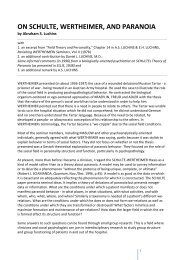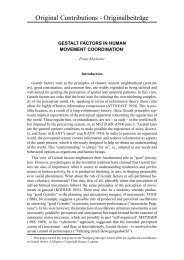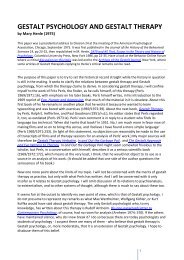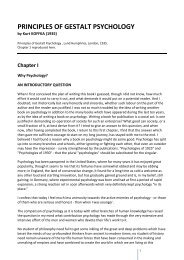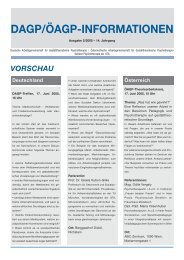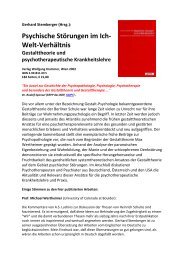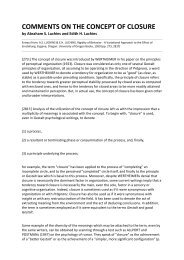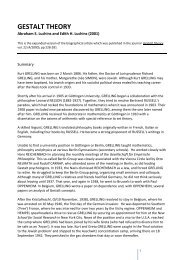pdf-Download - Society for Gestalt Theory and its Applications (GTA)
pdf-Download - Society for Gestalt Theory and its Applications (GTA)
pdf-Download - Society for Gestalt Theory and its Applications (GTA)
Create successful ePaper yourself
Turn your PDF publications into a flip-book with our unique Google optimized e-Paper software.
intersubjectivity, which are often used to characterize a science, cannot be maintained, in a strictsense, by the critical realists because they can ultimately be established only through subjectivemeans <strong>and</strong> thus one can be fundamentally in error. This can be confirmed by anyone who hasconsidered himself to be in a waking state, while, in fact, he was dreaming. This is because theworld in a dream state can have the same objective <strong>and</strong> intersubjective appearance as in a wakingstate. The possibility of making such a fundamental error, however, does not mean that we haveto adopt a completely skeptical position. Conviction does not always lead to objectively <strong>and</strong>intersubjectively valid observations, but it does so as a rule. Given that empirical phenomenology,by definition, does not seek to investigate objective facts, we dem<strong>and</strong> only intersubjectivity as acriterion <strong>for</strong> something's scientific character. Indeed, no single particular fact can be tested (e.g.,that someone has dreamed in color at a particular time). But more general facts, such as theactual occurrence of dreaming in color, <strong>for</strong> example, can be subjected to testing (<strong>for</strong> details seeTHOLEY, 1980b).Experimental phenomenology was the basic <strong>and</strong> most often used method in our lucid dreamresearch (<strong>for</strong> details see THOLEY, 1986a). With this method, the researcher instructs the subjectsor groups of subjects to carry out various specific activities during lucid dreaming, to observe theireffects <strong>and</strong> record their observations independently of each other immediately upon awakening.For judging the subjects' memory capabilities, it is important that they remember not onlyimmediate phenomenal facts, but also the conclusions <strong>and</strong> judgements made about these facts(see THOLEY, 1981). An interview technique developed by REIS (1989b), which is based on adetailed recording of dream experiences, allows <strong>for</strong> even more reliable <strong>and</strong> valid in<strong>for</strong>mation ondream content than one normally finds with the usual analyti-cal methods. With the help ofphenomenological experiments, it is possible to test psychological hypotheses about functionaldependencies on phenomenal facts, as well as psychophysiological hypotheses about therelationships between phenomenal <strong>and</strong> physiological facts.Objections to the control of dreams have recently emerged in the lucid dream literature. To theseobjections we can only reply that in our research <strong>and</strong> clinical work, we have obtained numerousresults through the control of dreams making it possible <strong>for</strong> us to help many people. The subjectsof pilot studies always participate voluntarily in our investigations <strong>and</strong> were always made aware ofpotential dangers. It is also underst<strong>and</strong>able that the content of our subjects' lucid dreams woulddiffer extensively from the reports of spontaneous lucid dreamers. Above all, our experimentalphenomenologicalfindings are distinguished from the results obtained by an analysis ofspontaneous lucid dreams by a significantly greater diver-sity of experiential possibilities.Phenomenological Research in Dream Perception <strong>and</strong> CognitionIn these experiments we tested a vast number of hypotheses in the area of per-ception <strong>and</strong>cognition during lucid dreaming which I have lectured on in detail since 1973 <strong>and</strong> which, in part,are only to be found in the unpublished reports <strong>and</strong> dissertations of my students. From among myGerman publications, I would highlight my review article of 1981.The phenomenological experiments on perception were first modeled on the usual perceptualexperiments in the waking state. We determined if double images, after images <strong>and</strong> reversiblephenomena appeared during lucid dreams under appro-priate conditions. These experiments alsohelped in identifying criterion <strong>for</strong> distin-guishing between a waking <strong>and</strong> a dream state (see above).We found that all of these phenomena were sometimes, if not always, observed. Although we canfrequently recognize the fact that we are dreaming, thirty years of research has still not given us5



